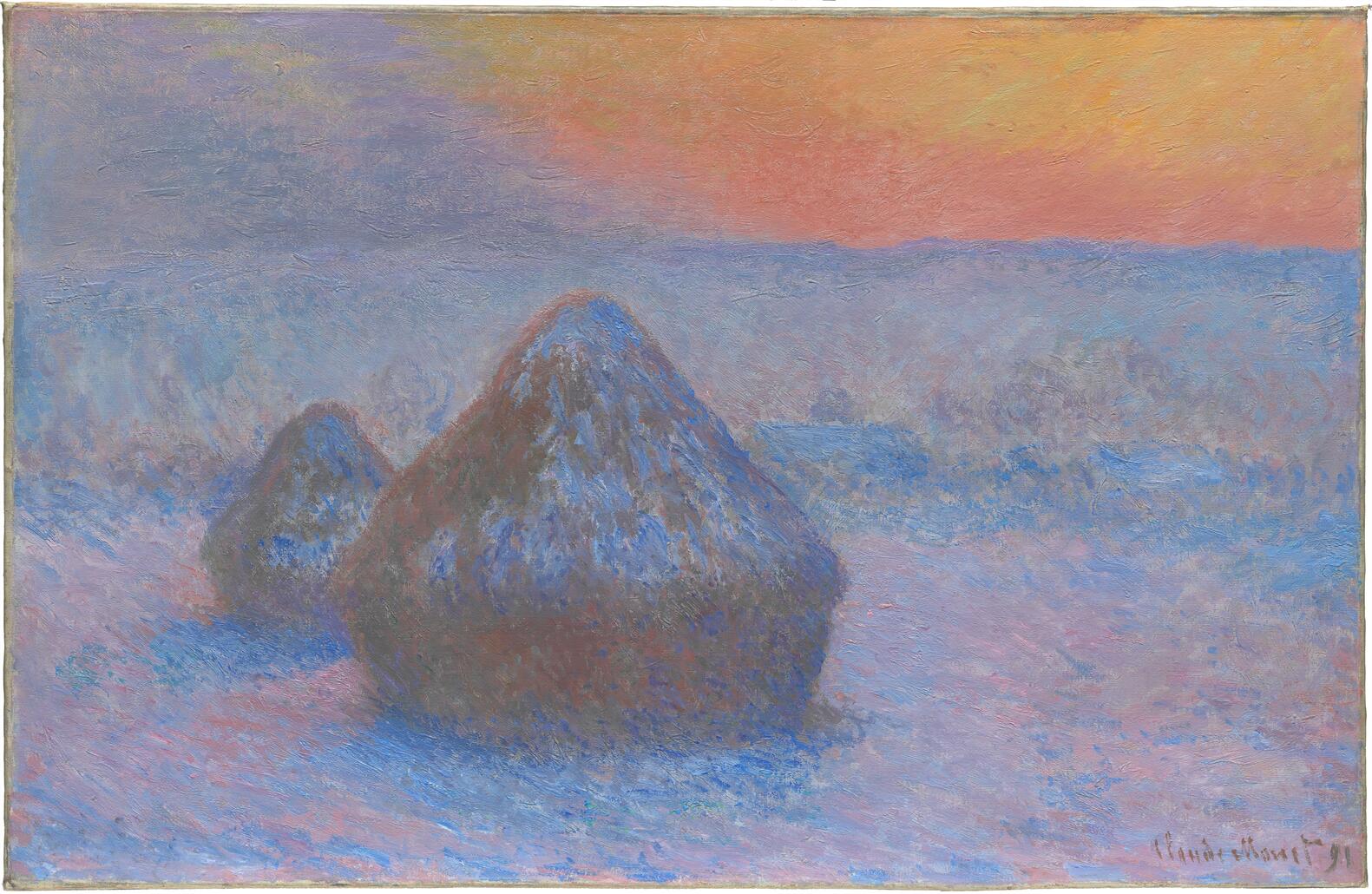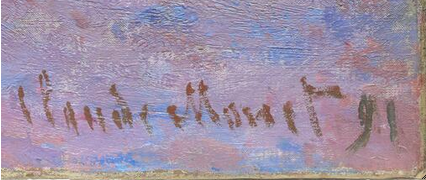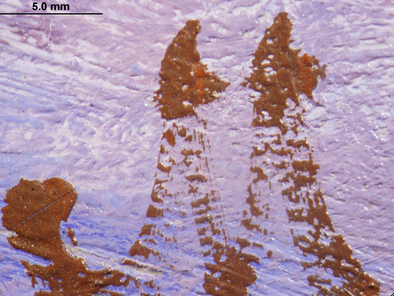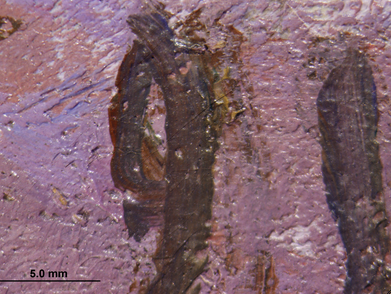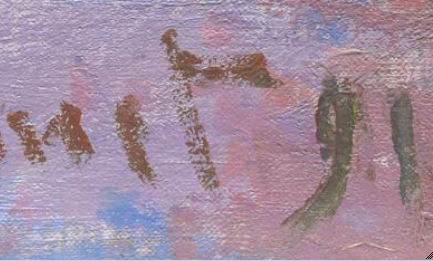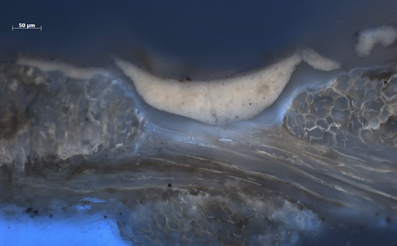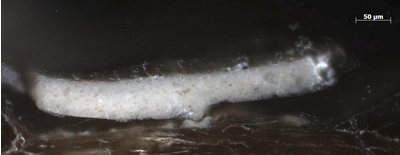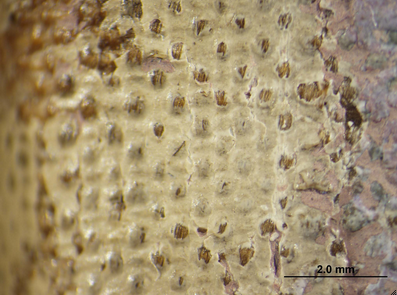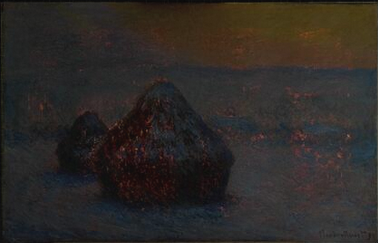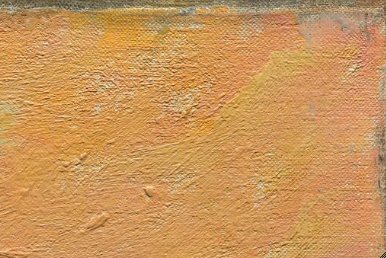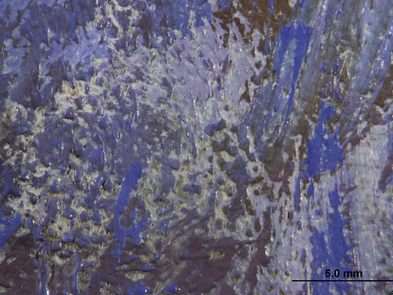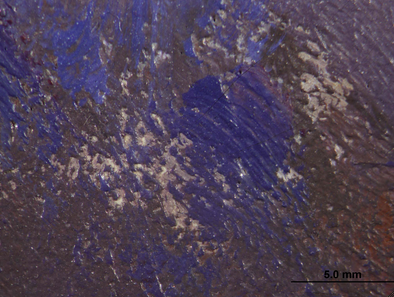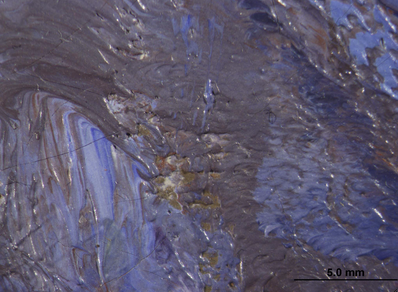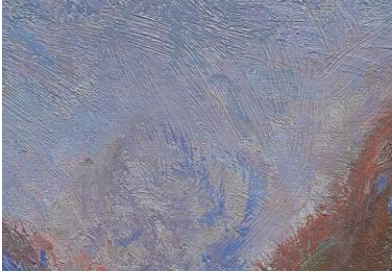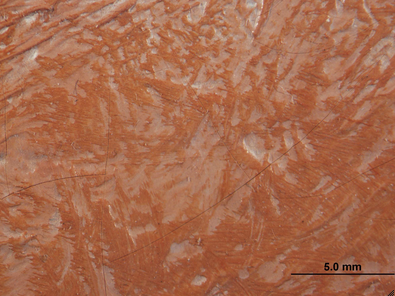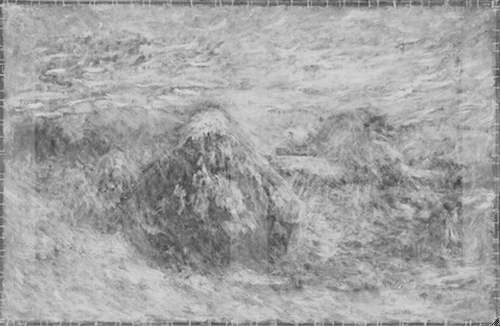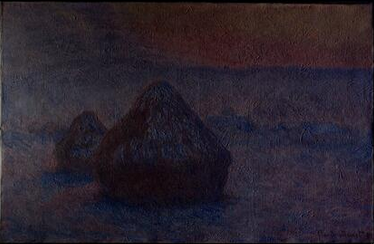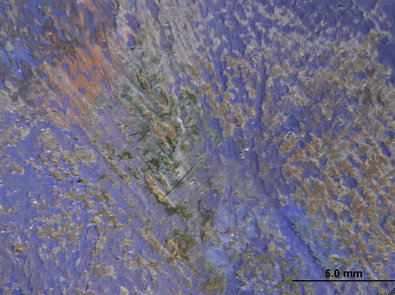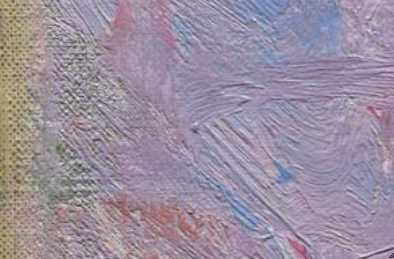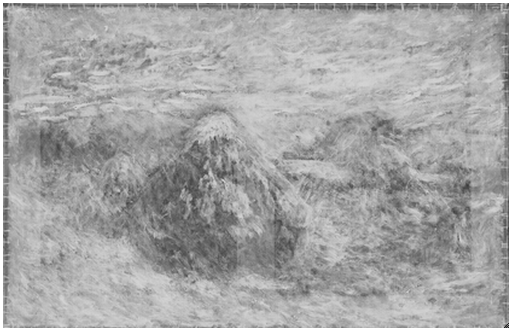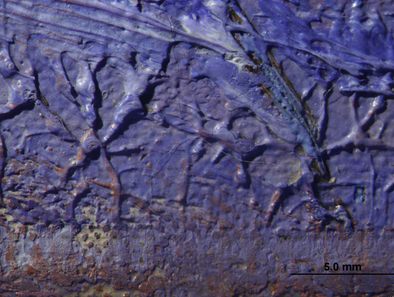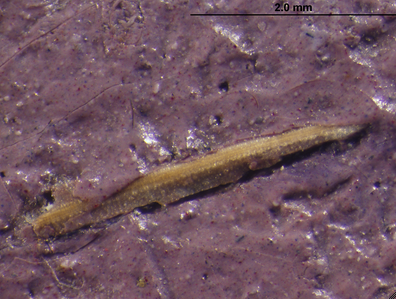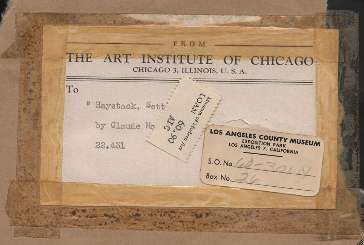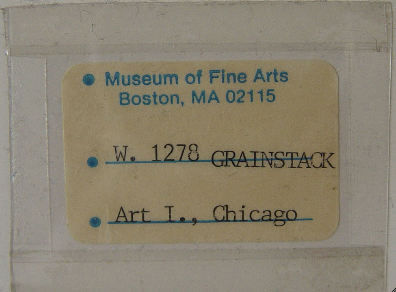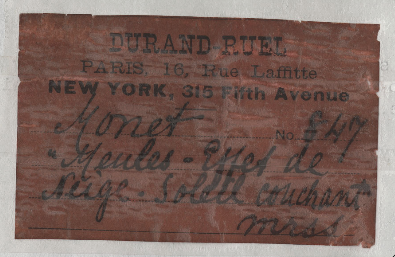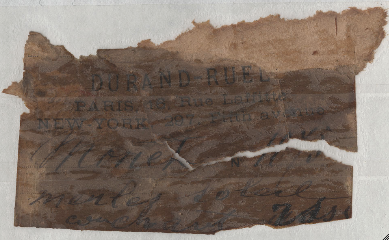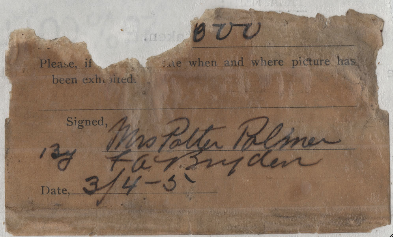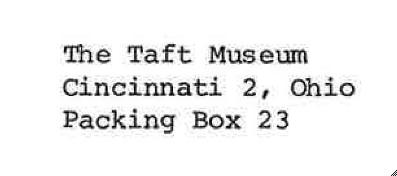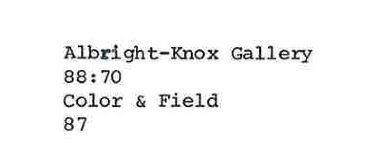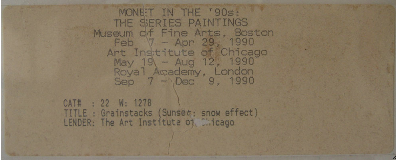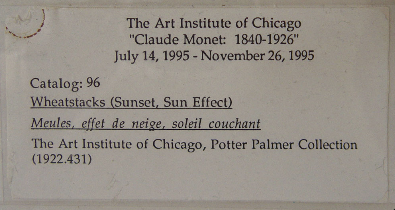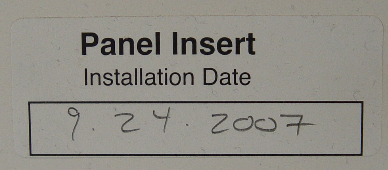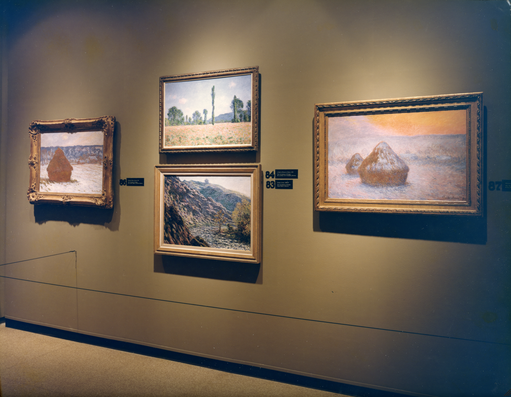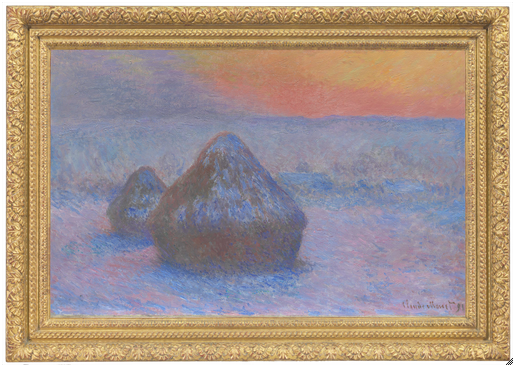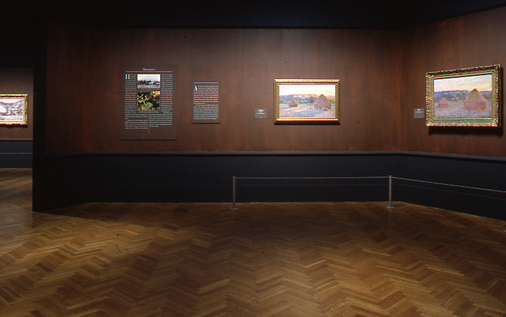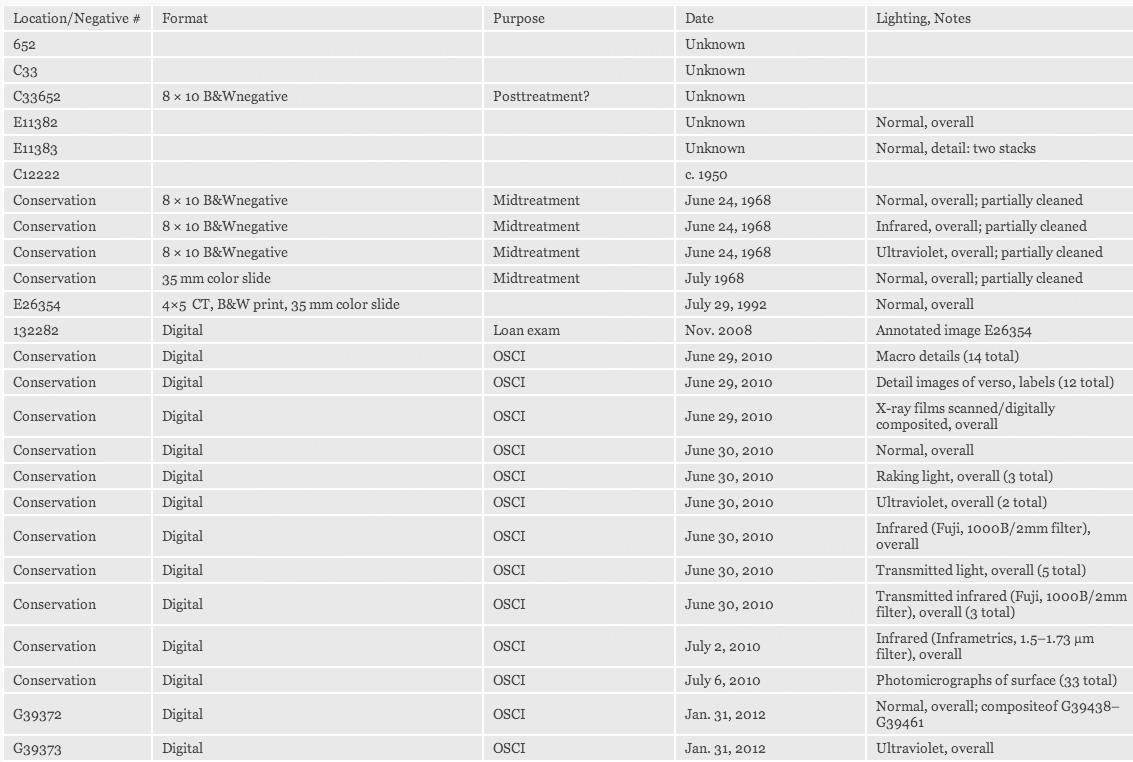Cat. 29
Stacks of Wheat (Sunset, Snow Effect)
1890/91
Oil on canvas; 65.3 × 100.4 cm (25 11/16 × 39 1/2 in.)
Signed and dated: Claude Monet 91 (lower right, name in reddish-brown paint, date in greenish-brown paint)
The Art Institute of Chicago, Potter Palmer Collection, 1922.431
Technical Report
Technical Summary
Claude Monet’s Stacks of Wheat (Sunset, Snow Effect) was painted on a pre-primed, no. 40 seascape (marine) standard-size linen canvas. The ground consists of a single, off-white layer. A stamp from the color merchant Troisgros Frères was documented on the back of the original stretcher. A warp-thread match was detected with seven other Monet paintings from the Art Institute’s collection: The Petite Creuse River (cat. 25 [W1231], inv. 1922.432), Stacks of Wheat (End of Summer) (cat. 27 [W1269], inv. 1985.1103), Stacks of Wheat (End of Day, Autumn) (cat. 28 [W1270], inv.), Stack of Wheat (Thaw, Sunset) (cat. 32 [W1284], inv. 1983.166), Sandvika, Norway (cat. 34 [W1397], inv. 1961.790), Branch of the Seine near Giverny (Mist) (cat. 36 [W1475], inv. 1933.1156), and Water Lily Pond (cat. 37 [W1628], inv. 1933.441), suggesting that the fabric for these paintings came from the same bolt of material. The painting is densely built up from a light-toned underpainting that laid out the main forms of the composition. In the process of painting, the artist made a significant change to the placement of the two stacks. At an earlier stage, the stacks appear to have been of a size comparable to those depicted in the final painting but were placed much further apart, closer to the left and right edges of the canvas. The horizon line also appears to have been painted in a significantly lower position in the earlier image. Some of the brushwork related to the earlier painting remains visible on the surface. The date, 91, appears to have been applied later and in a different color from the signature, after some pink brushstrokes added to the bottom right corner covered the original date.
Multilayer Interactive Image Viewer
The multilayer interactive image viewer is designed to facilitate the viewer’s exploration and comparison of the technical images (fig. 29.1).
Signature
Signed and dated: Claude Monet 91 (lower right, name in reddish-brown paint, date in greenish-brown paint) (fig. 29.2, fig. 29.3, fig. 29.4). The signature is executed in a reddish-brown paint and was applied when the underlying paint was dry. The date, on the other hand, consists of a dull, greenish-brown paint mixture and appears to have been added later, wet-in-wet, over a layer of pale-pink paint that was applied just to the corner area and that appears to cover an earlier date similar in color to the signature (fig. 29.5).
Structure and Technique
Support
Canvas
Flax (commonly known as linen).
Standard format
The original dimensions were approximately 65 × 100 cm, which corresponds to a no. 40 seascape (marine) standard-size stretcher.
Weave
Plain weave. Average thread count (standard deviation): 23.3V (0.5) × 22.2H (0.7) threads/cm. The vertical threads were determined to correspond to the warp and the horizontal threads to the weft. A warp-thread match was determined with seven other Monet paintings in the Art Institute’s collection: The Petite Creuse River (cat. 25 [W1231], inv. 1922.432), Stacks of Wheat (End of Summer) (cat. 27 [W1269], inv. 1985.1103), Stacks of Wheat (End of Day, Autumn) (cat. 28 [W1270], inv. 1933.444), Stack of Wheat (Thaw, Sunset) (cat. 32 [W1284], inv. 1983.166), Sandvika, Norway (cat. 34 [W1397], inv. 1961.790), Branch of the Seine near Giverny (Mist) (cat. 36 [W1475], inv. 1933.1156), and Water Lily Pond (cat. 37 [W1628], inv. 1933.441).
Canvas characteristics
There is mild cusping along the top and bottom edges, slightly more pronounced cusping on the left edge, and stronger and more irregular cusping along the right edge.
Stretching
Current stretching: Dates to the 1992 treatment (see Conservation History); copper tacks spaced approximately 2–5 cm apart. The painting appears to have been mounted on the stretcher slightly askew. Additional holes on all sides probably relate to the aluminum strip molding applied in 1959 (see Conservation History).
Original stretching: Tack holes, spaced approximately 6–8 cm apart, correspond to cusping in the canvas. A second series of tack holes is spaced more irregularly, approximately 5–10 cm apart, and does not align with the cusping pattern.
Stretcher/strainer
Current stretcher: Five-membered wood stretcher with vertical crossbar and keyable mortise and tenon joints, dating to the 1992 treatment (see Conservation History). Depth: 3 cm.
Original stretcher: Discarded. The pre-1968-treatment stretcher may have been the original stretcher. A diagram in the 1959 examination report indicates that the stretcher consisted of five members including a vertical crossbar, with keyable, butt-ended joints. Depth: Based on the presence of a crease in the tacking margin, presumably where excess fabric was folded over the back edge of the original stretcher, the depth was approximately 1.5 cm.
Manufacturer’s/supplier’s marks
The 1959 examination report records that there was a stamp on the back of the pre-1968-treatment stretcher (discarded): TROT [sic] . . . (?)OS FRÈRES / 35 Rue Victor Massé / Panneaux etc (fig. 29.6).
Preparatory Layers
Sizing
In UV light, evidence of a light blue fluorescence between the canvas and the ground suggests the presence of an organic layer, possibly glue sizing (fig. 29.7).
Ground application/texture
The ground layer extends to the edges of all four tacking margins, indicating that the canvas was cut from a larger piece of primed fabric, which was probably commercially prepared. The ground consists of a single layer and ranges from approximately 15 to 80 µm in thickness (fig. 29.8).
Color
The ground is off-white, with some dark particles visible under magnification (fig. 29.9).
Materials/composition
Analysis indicates the presence of the following components: lead white and calcium carbonate (chalk), with traces of bone black, iron oxide, alumina, silica, and various silicates. Binder: Oil (estimated).
Compositional Planning/Underdrawing/Painted Sketch
Extent/character
No underdrawing was observed with infrared reflectography (IRR) or microscopic examination.
Paint Layer
Application/technique and artist’s revision
Most of the landscape and the left side of the sky were executed in similarly soft shades of blue and pink, sometimes mixed to form pale-purple hues. These colors appear throughout these areas, but in general, pink was used for the reflections in the snow and a slightly more intense blue to denote the shadows. The artist worked in a fairly narrow tonal range, such that the transition from foreground to middle ground to sky is almost indistinguishable and the buildings in the distance are barely discernible. The stacks come into sharper focus through the use of more intensely colored strokes of blue and reddish-brown paint. The most intense color—shades of bright yellow, orange, and salmon pink (fig. 29.10)—were reserved for the evening sky. The paint layer is fairly continuous, with very little exposed ground visible at the surface. The dense buildup of paint is evident in both the transmitted light and X-ray images (fig. 29.11). Where a few small glimpses are afforded, there appears to be a light-toned underpainting that covers most of the ground layer. This often consists of pale shades of gray (fig. 29.12) or, underneath the stacks, subdued greens and pinkish browns (fig. 29.13, fig. 29.14). The brush-marked texture of this underpainting often remains visible on the surface of the painting.
The brushwork is relatively uniform over the surface. Brush marks are visible, but they are low relief and smoothed out in places, with very little impasto. The paint consistency ranges from quite fluid, exhibiting a smooth, settled surface with some swirling together of unmixed colors (fig. 29.15), to stiffer, more-bodied paint that holds the ridges of the brush marks (fig. 29.16). The painting combines areas of wet-in-wet mixing and wet-over-dry brushwork. In some areas, the artist used a scumbling technique in which he layered opaque, slightly more intense color on top of a lighter paint layer. This is apparent in the orange area of the sky, where deep orange-red paint was applied wet-over-dry with a small brush (2.0–3.0 mm in width), using short strokes that allow the pale orange layer underneath to show through (fig. 29.17). A similar effect was observed in the bluish-gray hill near the left edge (fig. 29.18). The light dragging of the upper paint layers here and throughout the painting emphasizes the texture of the underlying layers. This is particularly apparent in the areas of compositional changes (discussed below).
Technical examination has revealed a major compositional change in the placement of the two stacks. As is evident in both the X-ray and transmitted-infrared images, earlier in the painting process the stacks were positioned much farther apart (fig. 29.19). Although the sizes of both the large and the small stack seem comparable to those in the final painting, their outer edges were much closer to the left and right sides of the canvas, which would have left quite a large empty space in the middle of the composition. Brushstrokes from the earlier stacks, particularly the thicker strokes that delineate the edges, remain visible on the surface, especially when the painting is viewed in raking light (fig. 29.20). It is difficult to say how far these stacks were developed or whether they were painted in a different palette, since the paint applied on top is mostly continuous. In a few small areas of the large painted-out stack, however, some green paint was observed below the surface (fig. 29.21). A similar green area was detected below the pink and blue paint of the landscape at the left edge of the painting (fig. 29.22), perhaps providing evidence that the artist started the painting using a different color scheme. The artist may also have adjusted the position of the horizon line. There are some strong, roughly horizontal, curving brushstrokes above and below the current horizon, on the left and right sides of the painting. These are more clearly visible in the X-ray, which shows similar brushstrokes continuing throughout the sky. Based on this evidence, it seems that the horizon line may have originally been significantly lower, possibly with the peak of the large painted-out stack rising slightly above it (fig. 29.23).
A band of disturbed paint—caused by something having been pressed onto and then pulled away from the paint surface when it was still wet, drawing up low peaks—occurred along the bottom edge. The band is approximately 45 cm long and is positioned roughly in the middle of the canvas (29 cm from the left edge and 27 cm from the right edge) (fig. 29.24). This impression in the wet paint may have been caused by an easel cleat or transporting device. Subsequent brushstrokes were applied on top when the peaks of paint were dry, indicating that the disturbance to the wet paint occurred at some point during the execution of the work. A few inclusions, possibly of plant matter, were observed embedded in the paint layer, near the bottom-right corner (fig. 29.25).
Painting tools
Brushes including 0.3, 1.0, and 1.5 cm width, flat ferrule (based on width and shape of brushstrokes). There are several brush hairs embedded in the paint surface.
Palette
Analysis indicates the presence of the following pigments: lead white, cadmium yellow, chrome yellow, vermilion, red lake, viridian, cobalt blue, and ultramarine blue. UV fluorescence suggests the use of red lake throughout the landscape.
Binding media
Oil (estimated).
Surface Finish
Varnish layer/media
The painting was cleaned in 1992 and left unvarnished. It has a subtly variable surface—matte in some areas, low sheen in others—depending on the qualities of the paint. It is noted in the conservation file that the painting was cleaned and varnished in 1922. Its surface finish prior to this treatment was not documented (see Conservation History).
Conservation History
The painting was cleaned and varnished in 1922.
In 1954 the stretcher was keyed out to ameliorate slackening of the canvas.
Around 1959 the painting was surface cleaned with wax emulsions and backed with resin-coated paper board, and aluminum strip molding was attached along the edges.
In 1968 a “very heavy, yellowed” varnish was removed. The canvas was wax-resin lined and mounted on a new ICA spring stretcher. A layer of polyvinyl acetate (PVA) AYAA was applied. Minor inpainting was carried out. A layer of methacrylate resin L-46 was applied, followed by a final layer of AYAA.
In 1992 the wax-resin lining was removed. The canvas was edge lined and mounted on a new keyable wood stretcher with a loose lining. The synthetic varnish layers were removed, and the painting was left unvarnished.
Condition Summary
The painting is in good condition. The canvas is edge lined and loose lined with a panel insert. There are no planar deformations. Moderate cracking, abrasion, and small losses are present in the paint and ground layers around all of the edges, with some short splits in the canvas at the foldovers and holes at the corners. The paint layer is in excellent condition, with only a few tiny flake losses. There is minimal retouching, mostly at the top, left, and right edges. There is an overall network of fine cracks. Cracking is more extensive in the sky, but is visible mostly only under magnification. Stretcher-bar cracks are visible in the area of the original vertical crossbar. A few anomalous brown and gray paint strokes near the bottom left corner have the appearance of smudges or accretions but are probably original to the painting, since they appear to be wet-in-wet with the surrounding paint. There is some flattening of the paint and embedded wood fibers and debris in the frame rebate area, which appears to be due to framing when the paint was still soft. Several brush hairs are embedded in the paint surface. There are some light scratches and gouges in the blue paint at the bottom left corner and also to the right of the large stack, which occurred when the paint was still soft. The painting is currently unvarnished and has a natural matte finish with slight variations in gloss depending on the qualities of the paint. Some yellowed, natural-resin varnish residues and starch-paste residues from previous treatments are visible microscopically in the recesses of the paint texture. In places, these residues scatter the light and impart a whitish, milky appearance at certain angles. There are traces of gold paint in the frame rebate area.
Kimberley Muir
Frame
Current frame (installed in 1995): The frame is not original to the painting. It is a reproduction of a Louis XIII convex frame with carved acanthus leaves divided by an undulating ribbon, inner guilloche ornament bordered by hollows, and leaf-tip sight edge (Paul Mitchell Ltd., London 1995). The frame is water gilded over red bole on gesso. The hollows are burnished while the ornament is selectively burnished. The gilding is toned with thin washes of oil paint and glue size. The carved jelutong-wood molding is mitered and joined with dovetail splines. The molding, from perimeter to interior, is quirked ogee cyma recta; convex face with carved acanthus leaves divided by an undulating ribbon; fillet with rocked recutting; hollow; guilloche bordered by rocked recutting; hollow; torus with carved leaf tips; and cove sight (fig. 29.26).
Previous frame (a note on a 1969 loan request states the work “was re-framed in 1968 August”; removed 1995): The work was previously housed in an American mid-twentieth-century reproduction of a Louis XVI, gilt, architrave frame with ribbon-and-reel and bead-and-bobbin ornament (APF Inc., New York) (fig. 29.27, fig. 29.28).
Kirk Vuillemot
Provenance
Sold by the artist to Durand-Ruel, Paris, July 20, 1891, for 3,200 francs.
Sold by Durand-Ruel, Paris, to Durand-Ruel, New York, Oct. 30, 1891.
Sold by Durand-Ruel, New York, to Potter Palmer, Chicago, Feb. 29, 1892, for $13,000.
By descent from Potter Palmer (died 1902), Chicago, to the Palmer family.
Given by the Palmer family to the Art Institute of Chicago, 1922.
Exhibition History
Paris, Galeries Durand-Ruel, Exposition d’oeuvres récentes de Claude Monet, May 1891, cat. 13, as Meules. (Coucher du soleil; effet de neige.).
Boston, Copley Society, Loan Collection of Paintings by Claude Monet and Eleven Sculptures by Auguste Rodin, Mar. 1905, cat. 84, as Meules. Effet de Neige, Soleil Couchant. 1891. Lent by Mrs. Potter Palmer.
Art Institute of Chicago, Paintings from the Collection of Mrs. Potter Palmer, May 10–Nov., 1910, cat. 36, as Haystacks in winter.
Poughkeepsie (N.Y.), Vassar College, Art Department Picture of the Month, series 1 (circuit exhibition, organized by the American Federation of Arts), Nov. 1954; possibly La Jolla (Calif.) Art Center, Dec. 1954; Charleston, S.C., Gibbes Art Gallery, Jan. 1955; Columbus (Ga.) Museum of Arts and Crafts, Feb. 1955; possibly Seattle, Charles and Emma Frye Free Public Art Museum, Mar. 1955; Louisville, Ky., J. B. Speed Art Museum, Apr. 1955; Berea (Ky.), Berea College of Art Department, May 1955.
Park Forest (Ill.) Art Center, Mar. 25–Apr. 22, 1956, no cat.
Art Institute of Chicago, The Paintings of Claude Monet, Apr. 1–June 15, 1957, no cat. no.
New York, Museum of Modern Art, Claude Monet: Seasons and Moments, Mar. 9–May 15, 1960, cat. 52; Los Angeles County Museum, June 14–Aug. 7, 1960.
Buffalo. N.Y., Albright-Knox Art Gallery, Color and Field, 1890–1970, Sept. 15–Nov. 1, 1970, cat. 14 (ill.); Dayton (Ohio) Art Institute, Nov. 20, 1970–Jan. 10, 1971; Cleveland Museum of Art, Feb. 4–March 28, 1971.
Art Institute of Chicago, Paintings by Monet, Mar. 15–May 11, 1975, cat. 87 (ill.) (fig. 29.29).
New York, Metropolitan Museum of Art, Monet’s Years at Giverny: Beyond Impressionism, Apr. 19–July 9, 1978, cat. 13 (ill.); Saint Louis Art Museum, Aug. 1–Oct. 8, 1978.
Los Angeles County Museum of Art, A Day in the Country: Impressionism and the French Landscape, June 28–Sept. 16, 1984, cat. 112 (ill.); Art Institute of Chicago, Oct. 23, 1984–Jan. 6, 1985; Paris, Galeries Nationales d’Exposition du Grand Palais, as L’impressionnisme et le paysage français, Feb. 4–Apr. 22, 1985.
Art Institute of Chicago, The Art of the Edge: European Frames, 1300–1900, Oct. 17–Dec. 14, 1986, not in cat.
Boston, Museum of Fine Arts, Monet in the ’90s: The Series Paintings, Feb. 7–Apr. 29, 1990, cat. 22 (ill.); Art Institute of Chicago, May 19–Aug. 12, 1990; London, Royal Academy of Arts, Sept. 7–Dec. 9, 1990.
Art Institute of Chicago, Chicago’s Dream, a World’s Treasure: The Art Institute of Chicago, 1893–1993, Nov. 1, 1993–Jan. 9, 1994, no cat. no. (ill.).
Art Institute of Chicago, Claude Monet, 1840–1926, July 22–Nov. 26, 1995, cat. 96 (ill.). (fig. 29.30)
Washington, D.C., Phillips Collection, Impressionists in Winter: Effets de Neige, Sept. 19, 1998–Jan. 3, 1999, cat. 26 (ill.); San Francisco, Fine Arts Museums of San Francisco at the Center for the Arts at Yerba Buena Gardens, Jan. 30–May 2, 1999 (Washington only).
Hamburg, Hamburger Kunsthalle, Monets Vermächtnis: Serie—Ordnung und Obsession, Sept. 28, 2001–Jan. 6, 2002, no cat. no. (ill.).
Baltimore, Walters Art Museum, Déjà Vu? Revealing Repetition in French Masterpieces, Oct. 7, 2007–Jan. 1, 2008, cat. 58 (ill.); Phoenix Art Museum, Jan. 20–May 4, 2008.
Fort Worth, Tex., Kimbell Museum of Art, The Impressionists: Master Paintings from the Art Institute of Chicago, June 29–Nov. 2, 2008, cat. 77 (ill.).
Selected References
Galeries Durand-Ruel, Paris, Exposition Claude Monet, exh. cat. (Galeries Durand-Ruel, 1891), p. 16, cat. 13.
“Claude Monet Exhibit Opens,” Boston Post, Mar. 15, 1905.
Copley Society, Loan Collection of Paintings by Claude Monet and Eleven Sculptures by August Rodin, exh. cat. (Copley Society, 1905), p. 26, cat 84.
Art Institute of Chicago, Paintings from the Collection of Mrs. Potter Palmer, exh. cat. (Art Institute of Chicago, 1910), cat. 36.
Art Institute of Chicago, “Accessions and Loans,” Bulletin of the Art Institute of Chicago 16, 3 (May, 1922), p. 47.
M.C., “Monets in the Art Institute,” Bulletin of the Art Institute of Chicago 19, 2 (Feb. 1925), p. 20.
Art Institute of Chicago, A Guide to the Paintings in the Permanent Collection (Art Institute of Chicago, 1925), p. 146, cat. 835.
Art Institute of Chicago, The Art Institute of Chicago Handbook of Sculpture, Architecture, Paintings and Drawings (Chicago, 1932), p. 164, cat. 22.431.
Oscar Reuterswärd, Monet: En konstnärshistorik (Bonniers, 1948), p. 286.
American Federation of Arts, Picture of the Month: A Special Program Offered by the American Federation of Arts, exh. brochure (American Federation of Arts, 1954), pp. 1, cat. 4; 4 (ill.).
“Claude Monet Painting to be Shown at Gibbes Art Gallery,” News and Courier, Charleston, S. C., Sunday Morning, Dec. 26, 1954, p. Ten–B (ill.).
“April Picture of the Month,” J. B. Speed Art Museum Bulletin 16, 4 (Apr. 1955), p. 6 (ill.).
Art Institute of Chicago, “Catalogue,” Art Institute of Chicago Quarterly 51, 2 (Apr. 1, 1957), p. 33.
William C. Seitz, Claude Monet: Seasons and Moments, exh. cat. (Museum of Modern Art, New York/Los Angeles County Museum of Art/Doubleday, 1960), p. 61, cat. 52.
Art Institute of Chicago, Paintings in the Art Institute of Chicago: A Catalogue of the Picture Collection (Art Institute of Chicago, 1961), p. 320.
John Coplans, Serial Imagery, exh. cat. (Pasadena Art Museum, 1968), pp. 23, fig. 2c; 27.
Priscilla Colt, introduction to Color and Field, 1890–1970, exh. cat. (Albright-Knox Art Gallery/Dayton Art Institute/Cleveland Museum of Art, 1970), p. 16.
Albright-Knox Art Gallery, Dayton Art Institute, and Cleveland Museum of Art, Color and Field, 1890–1970, exh. cat. (Albright-Knox Art Gallery/Dayton Art Institute/Cleveland Museum of Art, 1970), p. 31, cat. 14 (ill.).
Grace Seiberling, “The Evolution of an Impressionist,” in Paintings by Monet, ed. Susan Wise, exh. cat. (Art Institute of Chicago, 1975), pp. 32, 33.
Susan Wise, ed., Paintings by Monet, exh. cat. (Art Institute of Chicago, 1975), p. 144, cat. 87 (ill.).
Taft Museum, Best of Fifty, exh. cat. (Taft Museum, 1977), pp. 62–63 (ill.).
Metropolitan Museum of Art, Monet’s Years at Giverny: Beyond Impressionism, exh. cat. (Metropolitan Museum of Art, New York, 1978), pp. 56, cat. 13 (ill.); 156.
Daniel Wildenstein, “Monet’s Giverny,” Metropolitan Museum of Art, Monet’s Years at Giverny: Beyond Impressionism, exh. cat. (Metropolitan Museum of Art, 1978), p. 21.
Daniel Wildenstein, Claude Monet: Biographie et catalogue raisonné, vol. 3, Peintures, 1887–1898 (Bibliothèque des Arts, 1979), pp. 38; 42, n. 1032; 140; 141, cat. 1278 (ill.).
Richard R. Brettell, “Monet’s Haystacks Reconsidered,” Art Institute of Chicago Museum Studies 11, 1 (Fall 1984), pp. 6; 7; 8–9, pl. 3; 14; 18, fig. 13 (ill.); 19.
Andrea P. A. Belloli, ed., A Day in the Country: Impressionism and the French Landscape, exh. cat. (Los Angeles County Museum of Art, 1984), p. 365.
Richard R. Brettell, “The Fields of France,” in A Day in the Country: Impressionism and the French Landscape, ed. Andrea P. A. Belloli, exh. cat. (Los Angeles County Museum of Art, 1984), pp. 246; 260–61; 271, no. 112 (ill.).
Richard R. Brettell, “La campagne française,” in Réunion des Musées Nationaux, L’impressionnisme et le paysage français, exh. cat. (Réunion des Musées Nationaux, 1985), pp. 261; 282–291. no. 112 (ill.).
Richard R. Brettell, Post-Impressionists (Art Institute of Chicago/Abrams, 1987), pp. 34–35 (detail), 37 (ill.), 118.
Paul Hayes Tucker, Monet in the ’90s: The Series Paintings, exh. cat. (Museum of Fine Arts, Boston/Yale University Press, 1989), cover (detail); pp. 3; 77; 80; 84–85, pl. 26 (overall and detail); 296, cat. 22.
John Sallis, “Monet’s Grainstacks: Shades of Time,” Tema Celeste 30 (Mar.–Apr. 1991), pp. 63; 65; 66 (ill.); 67.
Virginia Spate, Claude Monet: Life and Work (Rizzoli/Thames & Hudson, 1992), pp. 213; 215, ill. 231.
Neil Harris, Chicago’s Dream, a World’s Treasure: The Art Institute of Chicago, 1893–1993, ed. Teri J. Edelstein, afterword by James N. Wood, exh. cat. (Art Institute of Chicago, 1993), p. 31 (ill.).
William Mullen, “Art Institute Exhibit Hails Benefactors,” Chicago Tribune (Nov. 2, 1993), p. 1 (ill.).
George Keyes, “Claude Monet’s Grainstack, Sun in the Mist,” Arts 16, no. 12 (Dec. 1993), p. 7 (ill.).
Andrew Forge, Monet, Artists in Focus (Art Institute of Chicago, 1995), pp. 44; 47 (detail); 49; 88, pl. 17; 108.
Karin Hellandsjø, ed., Monet i Norge/Monet en Norvege/Monet in Norway, exh. cat. (Rogaland Kunstmuseum/Musée Rodin, 1995), pp. 49, 57 (ill.).
Charles F. Stuckey, with the assistance of Sophia Shaw, Claude Monet, 1840–1926, exh. cat. (Art Institute of Chicago/Thames & Hudson, 1995), pp. 117, cat. 96 (ill.); 220; 237.
Daniel Wildenstein, Monet, or The Triumph of Impressionism, cat. rais., vol. 1 (Taschen/Wildenstein Institute, 1996), pp. 268–69, cat. 1278 (detail); 275.
Daniel Wildenstein, Monet: Catalogue raisonné/Werkverzeichnis, vol. 3, Nos. 969–1595 (Taschen/Wildenstein Institute, 1996), pp. 489; 492, cat. 1278 (ill.); 500.
Carla Rachman, Monet (Phaidon, 1997), pp. 244; 245, fig. 157; 251.
Charles S. Moffett, “Effet de Neige: ‘Claude Monet and a Few Others…,’” in Charles S. Moffett, Eliza E. Rathbone, Katherine Rothkopf, and Joel Isaacson, Impressionists in Winter: Effets de neige, exh. cat. (Phillips Collection/Philip Wilson, 1998), pp. 20, 22.
Charles S. Moffett, Eliza E. Rathbone, Katherine Rothkopf, and Joel Isaacson, Impressionists in Winter: Effets de neige, exh. cat. (Phillips Collection/Philip Wilson, 1998), pp. 79; 211, cat. 26 (ill.).
Eliza E. Rathbone, “Road by Saint-Siméon Farm in Winter,” in Charles S. Moffett, Eliza E. Rathbone, Katherine Rothkopf, and Joel Isaacson, Impressionists in Winter: Effets de neige, exh. cat. (Phillips Collection/Philip Wilson Publishers, 1998), p. 82.
Katherine Rothkopf, “Rue Eugène Moussoir at Moret: Winter,” in Charles S. Moffett, Eliza E. Rathbone, Katherine Rothkopf, and Joel Isaacson, Impressionists in Winter: Effets de neige, exh. cat. (Phillips Collection/Philip Wilson, 1998), p. 188.
Katherine Rothkopf, “Stacks of Wheat (Snow Effect, Overcast Day); Stack of Wheat; Grainstacks: Snow Effect; Stacks of Wheat (Sunset, Snow Effect),” in Charles S. Moffett, Eliza E. Rathbone, Katherine Rothkopf, and Joel Isaacson, Impressionists in Winter: Effets de neige, exh. cat. (Phillips Collection/Philip Wilson, 1998), pp. 120; 122; 125, cat. 26 (ill.).
John Sallis, La mirada de las cosas: El arte como provocación (Universidad de Los Andes, 1998), pp. [6], fig. 6; 47, fig. 6; 115.
John Sallis, Shades—of Painting at the Limit (Indiana University Press, 1998), pl. 5; 26, note 13; 37, note 32; 47–48; 54.
James Henry Rubin, Impressionism, Art and Ideas (Phaidon, 1999), pp. 348; 351 fig. 224.
Carolyn Bailey Gill, ed., Time and the Image (Manchester University Press, 2000), cover (detail); pp. ix; pl. 1.
John Sallis, “Time and Image,” in Time and the Image, ed. Carolyn Bailey Gill (Manchester University Press, 2000), p. 20.
Art Institute of Chicago, Impressionism and Post-Impressionism in the Art Institute of Chicago, selected by James N. Wood (Art Institute of Chicago/Hudson Hills, 2000), p. 134 (ill.).
Gottfried Boehm, “‘Work’ and ‘Series’: Problems in Modern Conceptions of Pictorial Structure Since Monet,” in Monet and Modernism, ed. Karin Sagner-Düchting, exh. cat. (Prestel, 2001), p. 161 (ill.).
Annabelle Görgen, “‘Die Unschuld des Auges’: Serielle Wiederholung und die Suche nach den Ursprüngen,” in Monets Vermächtnis: Serie—Ordnung und Obsession, ed. Christoph Heinrich, exh. cat. (Hamburger Kunsthalle/Hatje Cantz, 2001), p. 45.
Christoph Heinrich, “Une série d’effets différents: Monets ‘Getreideschober’ als Hülle für das Licht, die Zeit, das Universum—und ‘die märchenhafte Kraft und Pracht der Malerei,’” in Monets Vermächtnis: Serie—Ordnung und Obsession, ed. Christoph Heinrich, exh. cat. (Hamburger Kunsthalle/Hatje Cantz, 2001), p. 17.
Christoph Heinrich, ed., Monets Vermächtnis: Serie—Ordnung und Obsession, exh. cat. (Hamburger Kunsthalle/Hatje Cantz, 2001), pp. 63 (ill.), 183.
Richard R. Brettell, From Monet to Van Gogh: A History of Impressionism, vol. 2 (Teaching Co., 2002), pp. 161, 166, 183.
Birgit Zeidler, Claude Monet: Life and Work, trans. by Paul Aston in association with Goodfellow & Egan (Könemann, 2005), p. 69 (ill.).
Eik Kahng, ed. The Repeating Image: Multiples in French Painting from David to Matisse, exh. cat. (Walters Art Museum/Yale University Press, 2007), p. 196, cat. 58 (ill.).
Charles F. Stuckey, “The Predications and Implications of Monet’s Series,” in The Repeating Image: Multiples in French Painting from David to Matisse, ed. Eik Kahng, exh. cat. (Walters Art Museum/Yale University Press, 2007), pp. 85; 86, fig. 1; 88.
Eric M. Zafran, “Monet in America,” in Wildenstein and Co., Claude Monet (1840–1926): A Tribute to Daniel Wildenstein and Katia Granoff, exh. cat. (Wildenstein, 2007), p. 112; 143, fig. 62b.
Gloria Groom and Douglas Druick, with the assistance of Dorota Chudzicka and Jill Shaw, The Impressionists: Master Paintings from the Art Institute of Chicago, exh. cat. (Art Institute of Chicago/Kimbell Art Museum, 2008), pp. 13; 22; 103; 108; 156; 158, cat. 77 (ill.). Simultaneously published as Gloria Groom and Douglas Druick, with the assistance of Dorota Chudzicka and Jill Shaw, The Age of Impressionism at the Art Institute of Chicago (Art Institute of Chicago/Yale University Press, 2008), pp. 13; 22; 103; 108; 156; 158, cat. 77 (ill.).
Jon Kear, The Treasures of the Impressionists (Andre Deutsch/Carlton, 2008), pp. 51 (ill.), 72.
Timothy A. Long, Bertha Honoré Palmer (Chicago Historical Society, 2009), p. 21 (ill.).
American Federation of Arts, AFA: A Century in the Arts (American Federation of Arts, 2010), p. 38 (ill.).
Laura Meixner, “‘Gambling with Bread’: Monet, Speculation, and the Marketplace,” Modernism/Modernity 17, 1 (Jan. 2010), p. 178, fig. 2.
Hervé Descottes, with Cecilia E. Ramos, Architectural Lighting: Designing with Light and Space (Princeton Architectural Press, 2011), p. 46, fig. 3.10.
Other Documentation
Archival Documentation from the Durand-Ruel Archives
Inventory number
Stock Durand-Ruel Paris 1075
Durand-Ruel, Paris, stock book 1891–1901
Inventory number
Stock Durand-Ruel New York 847
Durand-Ruel, New York, stock book 1888–93
Photograph number
Photo Durand-Ruel Paris 220
Other Documents
Label (fig. 29.31)
Label (fig. 29.32)
Labels and Inscriptions
Undated
Label
Location: previous Masonite-type backing board (discarded); transcription in conservation file
Method: unknown
Content: SL78.19.3 / Monet at Giverny / Art Institute of Chicago (fig. 29.33)
Label
Location: previous Masonite-type backing board (discarded); transcription in conservation file
Method: unknown
Content: 13 / Art Institute of Chicago (fig. 29.34)
Inscription
Location: previous frame; transcription in conservation file
Method: handwritten
Content: cat. # 14 (fig. 29.35)
Labels
Location: conservation file (large Art Institute label taped to brown paper with two smaller labels adhered to large label); original location not documented
1. Method: printed label with typewritten script
Content: FROM / THE ART INSTITUTE OF CHICAGO / CHICAGO 3, ILLINOIS, U.S.A. / To / “Haystack, Setting Sun” / by Claude Monet / 22.431
2. Method: printed label with typewritten script
Content: Museum of Modern Art / LOAN / 60.90 / AIC
3. Method: printed label with handwritten script
Content: LOS ANGELES COUNTY MUSEUM / EXPOSITION PARK / LOS ANGELES 7, CALIFORNIA / S.O. No. 60-301N / Box No. 26 (fig. 29.36)
Pre-1980
Stamp
Location: pre-1968-treatment stretcher (discarded), transcription in conservation file
Method: unknown
Content: TROT [sic] . . . (?)OS FRÈRES / 35 Rue Victor Massé / Panneaux etc (fig. 29.37)
Label
Location: pre-1968-treatment stretcher (discarded), preserved in conservation file
Method: printed label with handwritten script
Content: DURAND-RUEL / PARIS, 16, Rue Laffitte / NEW YORK, 315 Fifth Avenue / Monet No 847 / “Meules - Effet de / Neige. Soleil couchant” / mrss (fig. 29.31)
Label
Location: pre-1968-treatment stretcher (discarded), preserved in conservation file
Method: printed label with handwritten script
Content: DURAND-RUEL / PARIS, 16, Rue Laffitte / NEW-YORK 297, Fifth avenue / Monet No1075 [from transcription in conservation file] / meules soleil / couchant [. . .sss?] (fig. 29.32)
Label
Location: pre-1968-treatment stretcher (discarded), preserved in conservation file
Method: printed label with handwritten script
Content: [. . .] 00 / Please, if [possible, state] when and where picture has / been exhibited. [blank] / Signed, / Mrs Potter Palmer / By / F A Bryden / Date, 3/4-5 [?] (fig. 29.38)
Label
Location: previous Masonite-type backing board (discarded); transcription in conservation file
Method: unknown
Content: The Taft Museum / Cincinnati 2, Ohio / Packing Box 23 (fig. 29.39)
Label
Location: previous Masonite-type backing board (discarded); transcription in conservation file
Method: unknown
Content: Albright-Knox Gallery / 88:70 / Color & Field / 87 (fig. 29.40)
Post-1980
Label
Location: backing board
Method: printed label with typewritten script
Content: THE ART INSTITUTE OF CHICAGO / artist Monet, Claude / title Stacks of Wheat, Sunset Snow Effect / medium oil on canvas / credit Potter Palmer Collection / acc. # 1922.431 / LZ-341-001 1M 1/90 (Rev. 1/90) (fig. 29.41)
Label
Location: backing board
Method: printed label with typewritten script
Content: Museum of Fine Arts / Boston, MA 02115 / W. 1278 GRAINSTACK / Art I., Chicago (fig. 29.42)
Label
Location: backing board
Method: printed label
Content: MONET IN THE ’90S: / THE SERIES PAINTINGS / Museum of Fine Arts, Boston / Feb 7–Apr 29, 1990 / Art Institute of Chicago / May 19–Aug 12, 1990 / Royal Academy, London / Sep 7–Dec 9, 1990 / CAT# : 22 W: 1278 / TITLE: Grainstacks (Sunset: snow effect) / LENDER: The Art Institute of Chicago (fig. 29.43)
Label
Location: backing board
Method: printed label
Content: The Art Institute of Chicago / “Claude Monet: 1840–1926” / July 14, 1995–November 26, 1995 / Catalog: 96 / Wheatstacks (Sunset, Sun Effect) / Meules, effet de neige, soleil couchant / The Art Institute of Chicago, Potter Palmer Collection / (1922.431) (fig. 29.44)
Label
Location: backing board
Method: printed label with handwritten script
Content: Panel Insert / Installation Date / 9.24.2007 (fig. 29.45)
Label
Location: backing board
Method: printed label with handwritten script
Content: Panel Insert / Installation Date / 9.24.2007 (fig. 29.46)
Examination and Analysis Techniques
X-radiography
Westinghouse X-ray unit, scanned on Epson Expressions 10000XL flatbed scanner. Scans digitally composited by Robert G. Erdmann, University of Arizona.
Infrared Reflectography
Goodrich/Sensors Unlimited SU640SDV-1.7RT with J filter (1.5–1.7 µm); Inframetrics Infracam with 1.5–1.73 µm filter; and FujifilmS5 Pro with X-Nite 1000B/2 mm filter (1.0–1.1 µm).
Transmitted Infrared
Fujifilm S5 Pro with X-Nite 1000B/2 mm filter (1.0–1.1 µm).
Visible Light
Natural-light, raking-light, and transmitted-light overalls and macrophotography: Fujifilm S5 Pro with X-NiteCC1 filter.
Ultraviolet
FujifilmS5 Pro with X-NiteCC1 filter and Kodak Wratten 2E filter.
High-Resolution Visible Light (and Ultraviolet)
Sinar P3 camera with Sinarback eVolution 75 H (B+W 486 UV/IR cut MRC filter, X-NiteCC1 filter, and Kodak Wratten 2E filter).
Microscopy and Photomicrographs
Sample and cross-sectional analysis using a Zeiss Axioplan 2 research microscope equipped with reflected light/UV fluorescence and a Zeiss AxioCam MRc5 digital camera. Types of illumination used: darkfield, differential interference contrast (DIC), and UV. In situ photomicrographs with a Wild Heerbrugg M7A StereoZoom microscope fitted with an Olympus DP71 microscope digital camera
X-ray Fluorescence Spectroscopy (XRF)
Several spots on the painting were analyzed in situ with a Bruker/Keymaster TRACeR III-V with rhodium tube.
Polarized Light Microscopy (PLM)
Zeiss Universal research microscope.
Scanning Electron Microscopy/Energy-Dispersive X-ray Spectroscopy (SEM/EDX)
Cross sections analyzed after carbon coating with a Hitachi S-3400N-II VPSEM with an Oxford EDS and a Hitachi solid-state BSE detector. Analysis was performed at the Northwestern University Atomic and Nanoscale Characterization Experimental Center (NUANCE), Electron Probe Instrumentation Center (EPIC) facility.
Automated Thread Counting
Thread count and weave information were determined by Thread Count Automation Project software.
Image Registration Software
Overlay images registered using a novel image-based algorithm developed by Damon M. Conover (GW), John K. Delaney (GW, NGA), and Murray H. Loew (GW) of the George Washington University’s School of Engineering and Applied Science and the National Gallery of Art, Washington, D.C.
Image Inventory
The image inventory compiles records of all known images of the artwork on file in the Conservation Department, the Imaging Department, and the Department of Medieval to Modern European Painting and Sculpture at the Art Institute of Chicago (fig. 29.47).
